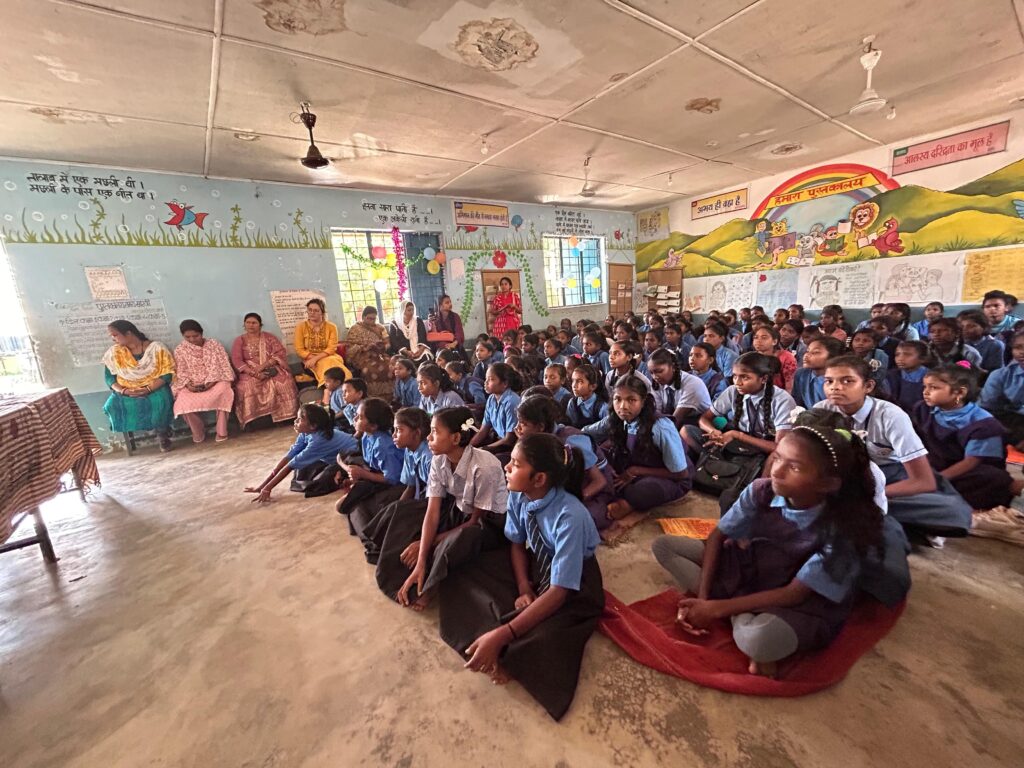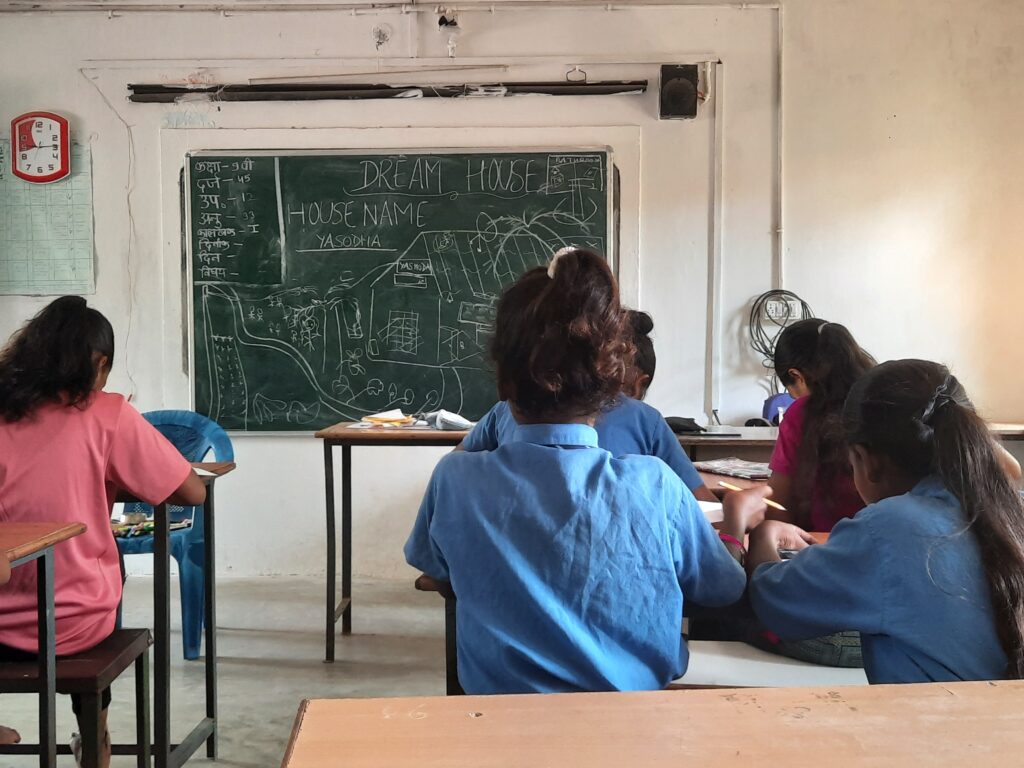When you hear the word pencil, what comes to your mind?
I use to think of a thin wooden piece with red, white and black stripes; with which I can write. It would probably be something in the similar lines for you as well. But what if I say that the word ‘PENCIL’ now holds a different meaning for me. The meaning of pencil or rather the perception of the commonality of the word changed as I got an opportunity to facilitate sessions on spoken English at a Summer Camp organized in a Porta Cabin School, in Murtonda Sukma. Shiksharth had volunteered to help organize these camps, thus my chance as a fellow to teach and learn again.
Teaching As An Experience
I was excited and equally nervous, the first time I heard of teaching at the summer camp. I have never taught anyone before. I even ran away from my elder sister duties of teaching and helping my younger sibling in their homework. So teaching children whom I have never known and who don’t speak the same language; was going to be new, to say the least. Thoughts and questions like would I be able to connect with the students? Do they feel comfortable talking to a temporary teacher? Kept bothering me.

Some of these worries did materialize on the opening day of the summer camp. When I got to know that students had gone home for their holidays and were asked to return for the camp. They didn’t look in the mood for studies. The only classes that they seemed overjoyed about were: Dance and Art.
Day 1
The first day of the regular class however was a bit different. I was accompanied by my colleague at Shiksharth. They had designed and prepared the framework of the upcoming sessions for this class. They have been working with children for years integrating experiential learning; which emphasizes on engaging in hands-on experiences and learning by doing. One of the methodologies adopted at Shiksharth is to promote collaborative learning. Which refers to student-owned experiences, leading to development of higher-level thinking skills like oral communication, self-management and leadership skills. They conducted the introductory class.
The class comprised of making an identity card. This card had a picture of the student, their details and decoration of their choice. This activity was followed with their introduction in English. I was observing my colleague throughout the session. Are the coloring activities required for an English class? Could we have not just started with learning the vocabulary for the self introduction? Is the input on spelling while translating a word in Hindi necessary? Do they smile at the kids, are they being funny, are they approachable? Am I suppose to imitate these actions?
Summer Camp : Spoken English
The summer camp was organized by the state government to promote co-curricular activities within the regular schedule. The camps were organized in government schools for classes 6-10. They were conducted from 8.30 to 11.00 in the morning and were entirely voluntary. The genres of the classes ranged from arts and crafts to dance, cooking, leadership, language and coding. The main goal of these camps is to entertain the children while providing a healthy environment to nurture their hidden talents and boost confidence.

The strength of my class were 17 on day 1; it however kept on fluctuating from moving up to 23 and coming down to 13 on the closing day. Some students left for home, some had registered for multiple classes thus were absent. The students were from multiple schools as well, out of which two were porta cabin schools and one a government high school. The group was heterogenous, thus it took time for the students to interact with each other.
The general aptitude for participation varied as well. Most of the students of public schools were pro-active, whereas majority students from the porta cabin schools were limited to instructions. The students from the visiting porta cabin school in Arrabore, were resistant to any interaction. During my initial interactions with the students I observed no initiated conversations. I made a point to stay within the class after sessions and during break. This gave space for the students to interact apart from schedule with each other as well as with me.
Language And What We Take For Granted
The first day of the class, in which I was observing and assisting. I came across a hurdle, that never occurred to me while prepping for the class. In the introductory class, students were attempting the task of creating their own identity cards. As I was only observing, I volunteered if they required any help, or any drawing materials. A student asked, “Ma’am cees“, puzzled I asked to repeat; the child confirmed, “cees Ma’am cees“. Another student seeing me struggle with the word, shouted, “Ma’am pencil maang raha hai” (ma’am they are asking for a pencil).
I couldn’t perceive that an English word as common as pencil would appear foreign in the class. This understanding came from how colloquially I had used English words like pencil, eraser, colgate, surf, cricket, book, bag. I had never stopped and pondered over how the words seeming so common could be entirely new vocabulary for some. After thinking about how the words seeming common to me would not be the actual baseline. I enquired what do they called ‘eraser’, a child replied “mithees“.
I was probably not ready for the sudden realization of how the concepts and words very familiar to me; hold no or least significance to the students. This led me back to my Psychology lectures for solutions. What would be some tools that can come handy? In situation where our means of communication; verbal language, was hindered. The importance of non-verbal communication became apparent. This is when the first class came back to me in its entirety. The reason my colleague used non-verbal gestures during session to seem approachable.
Non Verbal Cues
The students initially appeared very opposed to interaction despite various fun energizers. The language was anyway hindered, so I adopted to non verbal cues. This mostly consist of cues for communicating in class like thumbs up for ‘understood’, thumbs down for ‘doubt need clarity’. Maintaining a comfortable and lenient environment for the students appearing hesitant to communicate was of utmost priority. A gesture as simple as smiling worked wonders. Eye contacts though were difficult, I made sure that there significant number of activities involving students to interact with each other. Activities like greeting each other, keeping counts of everyone attending. These activities initially were facilitated, however later became autonomous. Students began explaining to each other the activities they liked or if someone had missed something fun.
Symbolism
The sessions plans designed for me would now came handy. I realized now the significance of coloring activities in an English class. Integrating drawing and symbolic representation were the cornerstones towards building our communication. All our sessions would include activity based projects. For instance, a class on farming tools, fruit names and family consisted of an activity to draw them and write their names in the local language.



One of the reasons for students being less expressive was inability to vocalize the feelings. I had observed that and even received feedback from the students at the end of the camp. The students said,” pehle kam logon se baat ki thi ab sab acche hain sab se baat karte hain”.(we use to talk to few people earlier, everyone is good and we talk to them). I made sure throughout the camp that the students feel comfortable to access the drawing materials kept within their class, whenever they desired. This helped in creating autonomy as well as expression within class.
Social Emotional Learning
The students were a mix group from different schools and age groups. The languages they spoke varied as well namely Dhurva, Halbi, Gondi and Oriya. Some students didn’t react to any interactions within the class. They would mostly part take in individual activities and avoid even slightest of eye contacts. This created a separation within the class, non verbal cues and symbolism were working for individual participation but not for collaboration. Students would complete an assignment if given to complete individually. But failed to complete a task involving others.
I decided to integrate some concepts of socio-emotional learning, to build emotional skills, social awareness, develop relationships and empathy. I began integrating mindfulness within session which encouraged students being mindful of oneself as well their surroundings. I conducted energizers and class activities which required participation of everyone in the group to proceed further.


I received feedback from the students during closing cirlce on the last day of the camp. The students said that they felt more connected with their classmates after sessions. They have made new friends, and the activity that they enjoyed the most was of making a school map together. This for me highlighted that working together initially was a task. However now they enjoyed being around each other and would even help each other in understanding the concepts. The students even initiated in revising concepts for each other after class in case someone missed.
Insights
The most significant part throughout the camp for me was the redefined importance of socio-emotional learning. The medium of instruction can vary from class to class. However the integration of socio emotional skills like developing relationships, self awareness, empathy creates positive classroom environment. During sessions implicit learnings of such skills followed by reflection result in a progressive growth in overall development.
Tools like non verbal symbolism, collaborative pedagogy help creating an environment that is for the child and by the child. A sense of autonomy is required in order to make learning fruitful. This helps in creating empathy for others making students emotionally and socially aware. Socio-emotional skills like social awareness, empathy, self-regulation are catalyst to various integral mental processes like decision making, regulating emotions and problem solving. Practice of developing these skills within classrooms should be part of regular learning.
The sessions and the ever-changing activities due to my naivety in teaching somehow resulted in a wonderful experience. I would forever remember my first teaching experience and the bunch of children who were kind enough to gift me such beautiful memories.

What Lies Ahead
The new Education Policy 2020 has highlighted the importance of socio-emotional learning in the holistic development of a child.
The implementation of the SEL (socio emotional learning) pedagogy within classroom is related to a Whole Child Approach to education. The whole-child approach emphasizes on focusing on the holistic development of a child. The learning environment is never limited to educational setup. The environments include home, community and school. The dimensions are expanded to cognitive, emotional, physical, behavioral and social. This results in a healthy development of thriving and learning child. The strategies to do so would include personalized, empowering, culturally affirming and transformative designs. This would result in the holistic well-being of the child in turn leading to an overall developed and contributing citizen.
The way forward to a holistic education model would be integrating teaching pedagogies like socio-emotional learning, collaboration and experiential pedagogy.



Hey people!!!!!
Good mood and good luck to everyone!!!!!